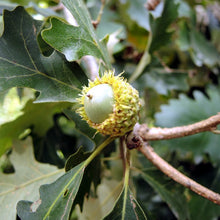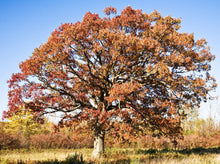|
Mature height x width: |
approx 50' x 50' |
|
Recommended initial spacing: |
5-10' in rows 25' apart |
|
Recommended final spacing: |
approx 50' apart |
| Hardy to: | approx -30°C |
|
Preferred soil: |
medium (loamy) and heavy (clay) soils, can tolerate heavy clay. |
|
Good for: |
marginal land, forest edge, savanna, livestock food |
|
Uses: |
grain substitute (flour), eaten raw or cooked, coffee substitute (roasted). |
Oaks have been an important food source for humans and animals throughout North America. Quercus macrocarpa AKA Bur Oak AKA Mossycup oak is among the fastest growing of the white oaks and it is tolerant of urban conditions and disturbed sites. Unlike many other oaks, its acorns have relatively low tannin content, making it more palatable to us humans. Like other oaks, remaining tannins can be leached out by soaking. Nuts can be roasted, boiled, or dried and milled into a flour.
This is truly a legacy tree: it may not produce acorns for a decade more, but these trees can live for hundreds of years and can grow up to 100' (even 130' in some cases) and its trunk can reach a diameter of 10'!
Planting: While oaks can germinate and grow in a forest, these oaks do best in a sunny spot. They can tolerate acidic soils and a wide range of climates (growing as far north as Alaska and as far south as Texas). Oaks are wind-pollinated so they require at least two to make acorns. Planting several in the same area helps to ensure adequate pollination. Water for the first few years while they're getting established. Best planted when dormant (Nov-Mar) but can be planted later in spring.
Why bare root? "Bare root" means that the tree has been grown in the ground (rather than in a pot). In general, bare root trees tend to have larger root systems because their roots aren't constricted by the edges of the pot. Because we don't need to use pots or potting soil, we can sell them more cheaply than potted trees. Bareroot trees should be planted when they are dormant (Nov - Mar in the Pacific Northwest; Nov - Apr in colder climates).



